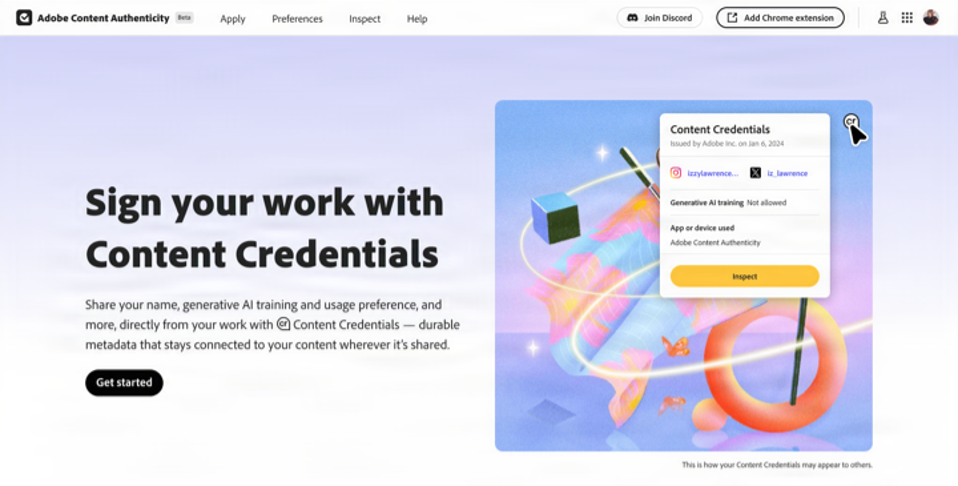
Adobe has announced the upcoming launch of a free web application designed to address the growing threats of misinformation and concerns about unauthorized content use. The Adobe Content Authenticity app allows creators to easily embed Adobe’s Content Credentials into their digital work, including images, audio and video files. These credentials function as a form of verifiable metadata, providing information about the creator and the content’s history, akin to a “nutrition label” for digital content.
The full web app is expected to launch in public beta in Q1 2025; creators can currently use Content Credentials within existing Adobe Creative Cloud applications such as Photoshop, Lightroom and Firefly. The beta version of the Content Authenticity extension for Google Chrome is currently available for early access.
Adobe Content Authenticity App Key Features And Functionality
The Adobe Content Authenticity app offers a user-friendly interface for applying Content Credentials. It allows creators to batch-process their work and include information such as their name, website and social media links. The app enables creators to specify whether they consent to their content being used to train generative AI models. This last feature, designed to function across various AI platforms, is in line with Adobe’s stated commitment to responsible AI development and should allow creators to control how their work is used.
Beyond empowering creators, Adobe also provides tools for end users to verify content authenticity and further enhance transparency. This is the rationale behind the Content Authenticity extension for Google Chrome mentioned above. The extension allows users to view Content Credentials associated with online content, even if the content has been reposted or captured via screenshot. This functionality ensures that provenance information remains persistently linked to the content.
Addressing The Growing Threat Of AI-Generated Misinformation
These initiatives are particularly crucial now, given the rise of AI-generated content—especially deepfakes—which pose a significant threat to the trustworthiness of digital media. By providing a standardized way to verify the origin and the edit history of a piece of content, Adobe aims to foster a more trustworthy digital ecosystem. Beyond the threat to public trust, the proliferation of AI-generated content has alarmed many creators. The new app addresses the concerns of creators who face unauthorized use and misattribution of their work. A recent Adobe study revealed that 91% of creators seek reliable methods for attributing their work, and 56% are worried about their content being used to train AI models without their consent.
Misuse of content by generative AI can have significant financial consequences. To illustrate the potential impact, consider the financial technology sector, where Deloitte predicts losses from generative AI-enabled fraud could reach $40 billion by 2027. This projection is tied to a significant global increase in deepfake incidents within fintech in 2023, demonstrating the speed at which AI technologies can be weaponized.
Building Trust And Transparency Across The Creative Ecosystem
To counter these threats and foster a more trustworthy digital environment, Adobe is championing a new era of transparency. In situations where the truthfulness of content is paramount, such as news reporting or documentary photography, Content Credentials offer a mechanism for establishing trust and accountability. Conversely, the new app enables transparency in situations where creators are engaging in artistic expression or experimentation, allowing them to indicate if a piece has been heavily edited or incorporates AI-generated elements.
“Content Authenticity is about transparency and trust in digital content,” said Andy Parsons, senior director of the Content Authenticity Initiative at Adobe. “It’s about empowering creators with control over their work and ensuring they have proper attribution.” He added, “It also equips companies and consumers with the information they need to make informed decisions about the content they encounter. This shared benefit cultivates a digital environment where provenance is readily available, allowing creativity and innovation to thrive within a framework of accountability and ethical engagement.”
To make this vision a reality, Adobe is actively working to expand the reach of the Content Authenticity Initiative, which now has more than 3,700 members. To do this, the company partners with key players across various platforms and industries to encourage widespread adoption. This collaboration includes integrating credentials into the products and services of major tech firms such as Microsoft and OpenAI, camera manufacturers including Sony, Leica and Nikon and media platforms such as TikTok. Adobe also works with news organizations including the Associated Press and advertising companies such as Publicis Groupe to promote the use of Content Credentials in journalism and creative industries.
Through these partnerships and its Content Authenticity Initiative, Adobe aims to establish Content Credentials as the industry standard for digital content transparency and attribution.
My Analyst Perspective
Tools such as Content Credentials have the potential to significantly address the challenges posed by AI-generated content and the erosion of trust in digital media. By providing a standardized method for verifying content origin and authorship, Adobe’s initiative could contribute to a more transparent and accountable online environment. The industry’s positive response to Content Credentials suggests a growing awareness of the need for such solutions; widespread adoption could lead to a significant shift in how digital content is created, shared and consumed.
However, the success of Content Credentials hinges on industry partnerships, technological advancements and user adoption. Creators must actively embrace and integrate Content Credentials into their workflows for them to become a genuinely effective standard. Furthermore, continued development by OEMs beyond Adobe’s initial partnerships, including makers of cameras and other capture devices with built-in Content Credentials functionality, will be crucial for ensuring widespread accessibility and ease of use.
Further development of the relevant software could expand the reach and functionality of Content Credentials. This could include firmware updates for cameras, tools for retroactively applying credentials to existing content, enhancing credential management with advanced features and extending support to a broader range of devices.
Regardless of the specifics, the effectiveness of Content Credentials will depend on a collaborative effort. My hope is that, by promoting transparency and accountability and equipping users with the necessary tools and knowledge, technology companies and users can work together to build a more trustworthy and authentic online experience.























































































